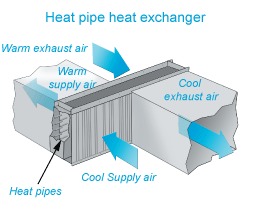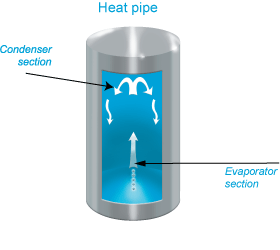​​​​​​​Heat Pipes
Reuse conditioned air and save
Heat pipes are made up of three or more tubes which are not interconnected. The tubes are filled with a heat transfer fluid and permanently sealed at both ends. The pipe is divided into two sections, a condenser section and evaporator section, which are separated by a partition plate. The air streams can be set up in counterflow or parallel flow patterns.
How it works
Heat is absorbed into the evaporating section which causes 
the fluid to boil to a vapor. The vapor then rises to the upper part of the cylinder where the heat is released. Then the vapor condenses back to a liquid state and returns by gravity to the lower part of the cylinder where it begins its cycle again. The cycle continues as long as there is a temperature difference between the two air streams.
Heat pipe energy recovery systems are sensible devices with efficiencies ranging from 45 to 65 percent. Efficiency can be lowered by the pressure drop of moving air through each side of the system.
 One of the advantages to a heat pipe energy recovery system is there is no threat of air stream cross contamination which allows the system to be used where high air pressure differentials exist between the two air streams. The lack of crossover air contamination and flexibility in construction materials also makes this a good option for corrosive environments.
One of the advantages to a heat pipe energy recovery system is there is no threat of air stream cross contamination which allows the system to be used where high air pressure differentials exist between the two air streams. The lack of crossover air contamination and flexibility in construction materials also makes this a good option for corrosive environments.
Capacity is controlled with face and bypass dampers or by tilting the pipes. With the exception of the tilt option, the system has no moving parts, making it easy to clean.